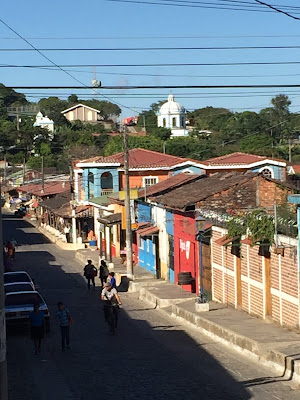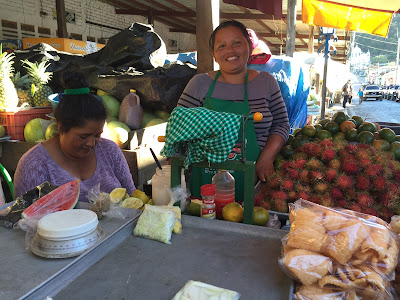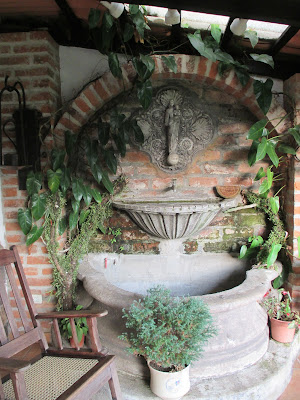Off the Beaten Path: Concepción de Ataco
If you are out in the western part of El Salvador, in the department of Auachapán, one of the best places to stop for a bite to eat, a bit of shopping and even an overnight stay is Concepción de Ataco, or as most people call it, simply Ataco. Ataco is a pretty popular tourist destination, especially among Salvadorans!
Prior to the conquest by Spain, Ataco was inhabited by the Pipil people. The town name originates from the Nahuat language and means "elevated place of springs." We tend to visit Ataco in conjunction with a visit to nearby hot springs such as Los Termales de Santa Teresa. Ataco is one of my favorite spots to take friends and delegations.
The "founding date" of the colonial town of Concepción of Ataco is considered to be January 15, 1543. The full name of the city (upgraded from "town" in 1999) comes from the name of Concepción de Ataco's parish church, the Immaculate Conception of Mary. The fiestas patronales honor the birth of Mary (traditionally September 7th) and have been celebrated for more than 200 years in Ataco with the custom of lighting thousands of farolitos (colorful little lanterns) to illuminate evening vespers.
Nestled in the Apaneca Mountains, Ataco has a cool and lovely climate. It is wise to carry both a sweater and a small umbrella (for rain or sun). The city is safe and walkable. Like most colonial cities, Ataco has a central square which features a lovely park, trees and a fountain. The parish church, Inmaculada Concepción de Maria, faces the square. It is typically easy to park near the church and to start your walking tour there. The current structure was completed in 2003 following the demolition of the previous church which was destroyed in the 2001 earthquakes. Respectfully go inside for a little time of reflection and to appreciate the beautiful interior.
Around the central square you will find plenty of shops, restaurants and cafes, as well as public restrooms (which will cost you a quarter). The art and jewelry shop near the restrooms has some unique creations for a fair price, and it's worth spending a little time chatting with the owner.
The city is set up in a grid, so you can walk as far out and back as you like in any direction, always keeping track of where you are in relation to the parish church. The main shopping areas are to the left (essentially south) as you exit the parish church. Up on the hill in the distance you will see a white church (El Calvario). You can use this church and the dome of the parish church to orient yourself.
Many of the streets are lined with outdoor shops. Ataco is a great place to find beautiful textiles, as well as pottery and the usual artisanal crafts. The indoor market is one block south of the parish church, and usually has a giant paper mache figure standing outside the main door. Inside you will find a good variety of things. The center courtyard is filled with antique looms. The weavers will gladly teach you about their craft, and you can grab a cup of coffee and a pastry while seated among the weavings.
About coffee...it's all around you! The mountains surrounding Ataco are rich in coffee production. Take some time to enjoy the local brew. You can purchase coffee to take home with you at any of the outdoor or indoor stores.
Ataco has several excellent restaurants. If you are looking for pupusas, I recommend Pupuseria Cielito Lindo (named for the big white cross and lookout which is above El Calvario). The dining space is small and simple, and the pupusas and hot chocolate are delicious. If you walk all the way to the southwest corner of town (about 4 long blocks west from the pupuseria), you will find the Piccolo Giardino restaurant. It's at the end of a dead end street, and maybe a little tricky to find the entrance but any driver or town person will be able to get you there. This is a good place for a large group. It features Italian pasta and pizza dishes with Salvadoran flair. The tables are nestled into covered spaces within a gorgeous garden. It is not ideal on very wet or humid days.
From the central square and parish church, if you head less than a half block north (right as you exit the church and on the right side of the street) you will find the Xochikalko Restaurant. Beautiful in the day or evening, this place features traditional Salvadoran favorites. At the corner of the next block, the Tayua Panaderia was one of my favorite places to get organic, hand-made pizza. The last couple of times I have visited, this restaurant was sadly closed.
If you decide to stay in Ataco for the evening or a few days, I highly recommend the Boutique Hotel Casa Degraciela. This is not a place for delegations, but for a romantic getaway, a respite for a smaller group or a family treat, this place is fantastic. The hotel was constructed in 1850 as the home for a coffee producer in the region. The family is significant in the town's history, having donated funds for the construction of many buildings, including the church. A few years ago, the family decided to open their home to the public by converting it into a small hotel. The service, the food and the accommodations are exquisite.
There are many corners of Ataco which I have yet to explore...so perhaps I will see you there sometime soon. It is definitely worth the drive!
Prior to the conquest by Spain, Ataco was inhabited by the Pipil people. The town name originates from the Nahuat language and means "elevated place of springs." We tend to visit Ataco in conjunction with a visit to nearby hot springs such as Los Termales de Santa Teresa. Ataco is one of my favorite spots to take friends and delegations.
The "founding date" of the colonial town of Concepción of Ataco is considered to be January 15, 1543. The full name of the city (upgraded from "town" in 1999) comes from the name of Concepción de Ataco's parish church, the Immaculate Conception of Mary. The fiestas patronales honor the birth of Mary (traditionally September 7th) and have been celebrated for more than 200 years in Ataco with the custom of lighting thousands of farolitos (colorful little lanterns) to illuminate evening vespers.
Nestled in the Apaneca Mountains, Ataco has a cool and lovely climate. It is wise to carry both a sweater and a small umbrella (for rain or sun). The city is safe and walkable. Like most colonial cities, Ataco has a central square which features a lovely park, trees and a fountain. The parish church, Inmaculada Concepción de Maria, faces the square. It is typically easy to park near the church and to start your walking tour there. The current structure was completed in 2003 following the demolition of the previous church which was destroyed in the 2001 earthquakes. Respectfully go inside for a little time of reflection and to appreciate the beautiful interior.
Around the central square you will find plenty of shops, restaurants and cafes, as well as public restrooms (which will cost you a quarter). The art and jewelry shop near the restrooms has some unique creations for a fair price, and it's worth spending a little time chatting with the owner.
The city is set up in a grid, so you can walk as far out and back as you like in any direction, always keeping track of where you are in relation to the parish church. The main shopping areas are to the left (essentially south) as you exit the parish church. Up on the hill in the distance you will see a white church (El Calvario). You can use this church and the dome of the parish church to orient yourself.
Many of the streets are lined with outdoor shops. Ataco is a great place to find beautiful textiles, as well as pottery and the usual artisanal crafts. The indoor market is one block south of the parish church, and usually has a giant paper mache figure standing outside the main door. Inside you will find a good variety of things. The center courtyard is filled with antique looms. The weavers will gladly teach you about their craft, and you can grab a cup of coffee and a pastry while seated among the weavings.
About coffee...it's all around you! The mountains surrounding Ataco are rich in coffee production. Take some time to enjoy the local brew. You can purchase coffee to take home with you at any of the outdoor or indoor stores.
Ataco has several excellent restaurants. If you are looking for pupusas, I recommend Pupuseria Cielito Lindo (named for the big white cross and lookout which is above El Calvario). The dining space is small and simple, and the pupusas and hot chocolate are delicious. If you walk all the way to the southwest corner of town (about 4 long blocks west from the pupuseria), you will find the Piccolo Giardino restaurant. It's at the end of a dead end street, and maybe a little tricky to find the entrance but any driver or town person will be able to get you there. This is a good place for a large group. It features Italian pasta and pizza dishes with Salvadoran flair. The tables are nestled into covered spaces within a gorgeous garden. It is not ideal on very wet or humid days.
 |
| A bit of the garden at Restaurante Giordano |
From the central square and parish church, if you head less than a half block north (right as you exit the church and on the right side of the street) you will find the Xochikalko Restaurant. Beautiful in the day or evening, this place features traditional Salvadoran favorites. At the corner of the next block, the Tayua Panaderia was one of my favorite places to get organic, hand-made pizza. The last couple of times I have visited, this restaurant was sadly closed.
If you decide to stay in Ataco for the evening or a few days, I highly recommend the Boutique Hotel Casa Degraciela. This is not a place for delegations, but for a romantic getaway, a respite for a smaller group or a family treat, this place is fantastic. The hotel was constructed in 1850 as the home for a coffee producer in the region. The family is significant in the town's history, having donated funds for the construction of many buildings, including the church. A few years ago, the family decided to open their home to the public by converting it into a small hotel. The service, the food and the accommodations are exquisite.
 |
| Entrance to Casa Degraciela |
There are many corners of Ataco which I have yet to explore...so perhaps I will see you there sometime soon. It is definitely worth the drive!
















Comments
Post a Comment